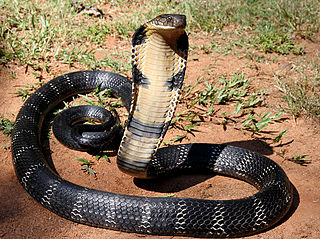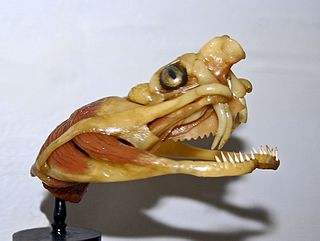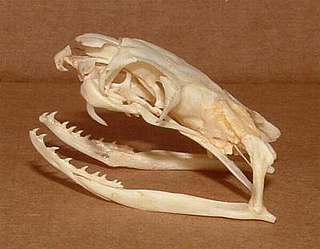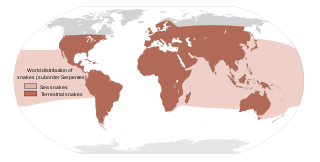| Genus [14] | Taxon
author [14] | Species [14] | Subspecies* [14] | Common
name | Geographic
range [8] |
|---|
| Acanthophis | Daudin, 1803 | 8 | 0 | death adders | Australia, New Guinea, Indonesia (Seram Island and Tanimbar) |
| Aipysurus | Lacépède, 1804 | 7 | 1 | olive sea snakes | Timor Sea, South China Sea, Gulf of Thailand, and coasts of Australia (Northern Territory, Queensland, Western Australia), New Caledonia, Loyalty Islands, southern New Guinea, Indonesia, western Malaysia and Vietnam |
| Antaioserpens | Wells & Wellington, 1985 | 2 | 0 | burrowing snakes | Australia |
| Aspidelaps | Fitzinger, 1843 | 2 | 4 | shieldnose cobras | South Africa (Cape Province, Transvaal), Namibia, southern Angola, Botswana, Zimbabwe, Mozambique |
| Aspidomorphus | Fitzinger, 1843 | 3 | 3 | collared adders | New Guinea |
| Austrelaps | Worrell, 1963 | 3 | 0 | Australian copperheads | Australia (South Australia, New South Wales, Victoria, Tasmania) |
| Brachyurophis | Günther, 1863 | 7 | 0 | shovel-nosed snakes | Australia |
| Bungarus | Daudin, 1803 | 12 | 4 | kraits | India (incl. Andaman Islands), Myanmar, Nepal, Vietnam, Afghanistan, Pakistan, Sri Lanka, Bangladesh, Cambodia, Indonesia (Java, Sumatra, Bali, Sulawesi), Peninsular Malaysia, Singapore, Taiwan, Thailand |
| Cacophis | Günther, 1863 | 4 | 0 | rainforest crowned snakes | Australia (New South Wales, Queensland) |
| Calliophis | Gray, 1834 | 15 | 11 | Oriental coral snakes | India, Bangladesh, Sri Lanka, Nepal, Indonesia, Cambodia, Malaysia, Singapore, Thailand, Burma, Brunei, the Philippines, Vietnam, Laos, southern China, Japan (Ryukyu Islands), Taiwan |
| Cryptophis | Worrell, 1961 | 5 | 0 | | Australia and Papua New Guinea |
| Demansia | Gray, 1842 | 9 | 2 | whipsnakes | New Guinea, continental Australia |
| Dendroaspis | Schlegel, 1848 | 4 | 1 | mambas | Sub-Saharan Africa |
| Denisonia | Krefft, 1869 | 2 | 0 | ornamental snakes | Central Queensland and central northern New South Wales, Australia |
| Drysdalia | Worrell, 1961 | 3 | 0 | southeastern grass snakes | Southern Australia (Western Australia, South Australia, Victoria, Tasmania, New South Wales) |
| Echiopsis | Fitzinger, 1843 | 1 | 0 | bardick | Southern Australia (Western Australia, South Australia, Victoria, New South Wales) |
| Elapognathus | Boulenger, 1896 | 2 | 0 | southwestern grass snakes | Western Australia |
| Elapsoidea | Bocage, 1866 | 10 | 7 | African or venomous garter snakes (not related to North American garter snakes, which are harmless to humans) | Sub-Saharan Africa |
| Emydocephalus | Krefft, 1869 | 3 | 0 | turtlehead sea snakes | The coasts of Timor (Indonesian Sea), New Caledonia, Australia (Northern Territory, Queensland, Western Australia), and in the Southeast Asian Sea along the coasts of China, Taiwan, Japan, and the Ryukyu Islands |
| Ephalophis | M.A. Smith, 1931 | 1 | 0 | Grey's mudsnake/ mangrove sea snake | Northwestern Australia |
| Furina | A.M.C. Duméril, 1853 | 5 | 0 | pale-naped snakes | Mainland Australia, southern New Guinea, Aru Islands |
| Hemachatus | Fleming, 1822 | 1 | 0 | rinkhals/ring-necked spitting cobra | South Africa, Zimbabwe, Lesotho, Eswatini |
| Hemiaspis | Fitzinger, 1861 | 2 | 0 | swamp snakes | Eastern Australia (New South Wales, Queensland) |
| Hemibungarus | W. Peters, 1862 | 3 | 0 | Barred coral snakes | Philippines (Luzon, Panay, Negros, Cebu, Mindoro, Catanduanes, Polillo is.) |
| Hoplocephalus | Wagler, 1830 | 3 | 0 | broad-headed snakes | Eastern Australia (New South Wales, Queensland) |
| Hydrelaps | Boulenger, 1896 | 1 | 0 | Port Darwin mudsnake | Northern Australia, southern New Guinea |
| Hydrophis | Latreille In Sonnini & Latreille, 1801 | 34 | 3 | sea snakes | Indoaustralian and Southeast Asian waters. [15] |
| Incongruelaps † | | 1 | 0 | | Riversleigh, Australia [16] |
| Laticauda | Laurenti, 1768 | 5 | 0 | sea kraits | Southeast Asian and Indo-Australian waters |
| Loveridgelaps | McDowell, 1970 | 1 | 0 | Solomons small-eyed snake | Solomon Islands |
| Microcephalophis | Lesson, 1832 | 1 | 0 | narrow-headed sea snake, graceful small-headed slender seasnake, common small-headed sea snake | on the coasts of the Indian Ocean and West Pacific, from around the Persian Gulf (Bahrain, Qatar, Saudi Arabia, Oman, United Arab Emirates (UAE), Iran, Iraq and Kuwait) to Pakistan, India, Sri Lanka, Bangladesh, Myanmar, Thailand, and Indonesia, and into the Malay Archipelago/West Pacific in Thailand, Malaysia, Singapore, Cambodia, Vietnam, the Philippines, southern China, Hong Kong, and Taiwan, as well as in Australia (Queensland) and Papua New Guinea |
| Micropechis | Boulenger, 1896 | 1 | 0 | New Guinea small-eyed snake | New Guinea |
| Micruroides | K.P. Schmidt, 1928 | 1 | 2 | Western coral snakes | United States (Arizona, southwestern New Mexico), Mexico (Sonora, Sinaloa) |
| Micrurus | Wagler, 1824 | 83 | 51 | coral snakes | Southern North America, South America |
| Naja | Laurenti, 1768 | 39 | 3 | cobras | Africa, Asia |
| Neelaps | (A.M.C. Duméril, Bibron & A.H.A. Duméril, 1854) | 2 | 0 | | Australia |
| Notechis | Boulenger, 1896 | 2 | 0 | tiger snakes | Southern Australia, including many offshore islands |
| Ogmodon | W. Peters, 1864 | 1 | 0 | bola | Fiji |
| Ophiophagus | Günther, 1864 | 1 | 0 | King cobra | Bangladesh, Myanmar, Cambodia, China, India, Andaman Islands, Indonesia, Laos, Thailand, Vietnam, western Malaysia, the Philippines |
| Oxyuranus | Kinghorn, 1923 | 3 | 2 | taipans | Australia, New Guinea |
| Parahydrophis | Burger & Natsuno, 1974 | 1 | 0 | Northern mangrove sea snake | Northern Australia, southern New Guinea |
| Parapistocalamus | Roux, 1934 | 1 | 0 | Hediger's snake | Bougainville Island, Solomons |
| Paroplocephalus | Keogh, Scott & Scanlon, 2000 | 1 | 0 | Lake Cronin snake | Western Australia |
| Pseudechis | Wagler, 1830 | 7 | 0 | black snakes (and king brown) | Australia |
| Pseudohaje | Günther, 1858 | 2 | 0 | tree cobras | Angola, Burundi, Cameroon, Central African Republic, Democratic Republic of the Congo, Congo, Gabon, Ghana, Kenya, Nigeria, Rwanda, Uganda, Sierra Leone, Liberia, Ivory Coast, Togo, Nigeria |
| Pseudonaja | Günther, 1858 | 8 | 2 | venomous brown snakes (and dugites) | Australia |
| Rhinoplocephalus | F. Müller, 1885 | 1 | 0 | Müller's snake | Western Australia |
| Salomonelaps | McDowell, 1970 | 1 | 0 | Solomons coral snake | Solomon Islands |
| Simoselaps | Jan, 1859 | 13 | 3 | Australian coral snakes | Mainland Australia |
| Sinomicrurus | Slowinski, Boundy & Lawson, 2001 | 8 | 6 | | Asia |
| Suta | Worrell, 1961 | 11 | 0 | hooded snakes (and curl snake) | Australia |
| Thalassophis | P. Schmidt, 1852 | 1 | 0 | anomalous sea snake | South Chinese Sea (Malaysia, Gulf of Thailand), Indian Ocean (Sumatra, Java, Borneo) |
| Toxicocalamus | Boulenger, 1896 | 11 | 0 | New Guinea forest snakes | New Guinea (and nearby islands) |
| Tropidechis | Günther, 1863 | 1 | 0 | rough-scaled snake | Eastern Australia |
| Vermicella | Gray in Günther, 1858 | 6 | 0 | bandy-bandies | Australia |
| Walterinnesia | Lataste, 1887 | 2 [17] | 0 | black desert cobra | Egypt, Israel, Lebanon, Syria, Jordan, Iraq, Iran, Kuwait, Saudi Arabia, Turkey [18] |
|






















